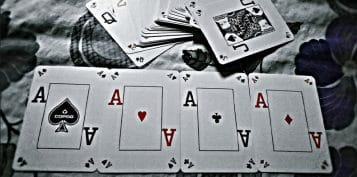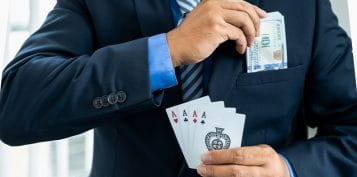MIT Blackjack Team – Terrorising the Casino System
We all have been witnesses to many blackjack champions who have earned their living with playing on the casino floor. None of them has made as many headlines as the infamous MIT Blackjack Team. With their card-counting abilities, they have descended upon countless casinos across the US and have notoriously proven that the brick-and-mortar venues can be beaten. Keep reading as we tell their story in the following paragraphs.
The MIT Blackjack Team – Why Blackjack?
Out of the most successful table games, it’s a common fact that blackjack can be beaten if a skilled player was to utilise a technique successfully. With roulettes, the player’s fate is decided by the spinning ball. Poker relies heavily on the player’s ability to bluff, and winning at baccarat is a stroke of pure luck. When you play blackjack and face the dealer, one can technically predict the right move by keeping track of what cards have come up and which are left in the deck, thus increasing the chances to turn things around.
Most blackjack variations are among the table casino games with the smallest House Edge percentage. This means that players have the best chances to return the most on their investment in the long run. What card counting and the MIT Blackjack Team members have done here is to eliminate the casino’s advantage and turn it around favouring the players. The result is a successful strategy for the team and a lot of lost money for the casinos.
How Did It All Start?
It all started with a fresh Harvard graduate named Bill Kaplan and a group of students attending the Massachusetts Institute of Technology (MIT). Upon being inspired by the novel “How to Beat the Dealer” by Edward O. Thorp, Bill decided to move to Las Vegas and implement his statistical and mathematical skills into cracking the game.
As time passed by, he and his team were already well-known by all casino executives in town. It wasn’t until a fateful day at a local restaurant when he was sharing details of his exploits, and all took a turn, as Bill Kaplan recalls. His conversation was overheard by a bunch of MIT students who had just started playing blackjack and were wondering how to make money out of it. After a few discussions, they all teamed up, and the rest is history. The legendary MIT Blackjack Team was born.

MIT Blackjack Team Strategy – What Techniques Are There?
One of the main reasons why the MIT Blackjack Team members went after this particular game – aside from the techniques – is because it is legal, technically. For as long as the players do the counting in their heads, the only nerves they can get on would be the ones of the casino owners, who do have the right to throw you out. Refrain from using electronic devices, and you will be fine until you get caught, eventually.
Even though the MIT Blackjack strategy consisted primarily of card counting, there are several techniques that a skilled player can utilise to increase the player advantage and win more money from the casino in the long haul. Let’s check out, which are the three most widely used techniques right up next.
- Card Counting – The most popular strategy, employed by the members of the MIT Blackjack Team. It’s objective is to give the counter enough information regarding the remaining deck of cards so that he/she can calculate the probabilities and subsequent moves and optimise the winning aspect.
- Shuffle Tracking – The shuffle track is a bit more advanced and equally legal. Here, the player observes a predetermined subsection of cards and maps its count as the cards get shuffled. The aim is to estimate the cards’ location based on the shuffle’s analysis and determine the odds as the game progresses.
- Hole Carding – Hole carding is a technique employed by the most observant of players. The goal here is to spot the usually hidden cards – not dealt in a face-up position – and determine the next move based on the acquired information. The hole carding technique can boost the player’s advantage by a whopping 13% when used smartly.
MIT Blackjack Team and Card Counting
Because card counting was the primary form of “cheating” for the MIT Blackjack Team members, let’s expand a bit more on it and see how it really worked in action. The main idea is to have all cards in the deck divided and grouped as per which side they are more favourable to. One would benefit the casino, and the other is advantageous for the MIT Blackjack Team. The 3rd category is where the rest of the cards are assigned. Here is what the grouping looks like:
- High Cards – 10s, Jack, Queen, King, and Ace count as -1
- Low Cards – 2s, 3s, 4s, 5s, and 6s count as +1
- The Rest – 7s, 8s, and 9s count as 0
It is statistically proven that the higher cards are more beneficial for the players, whereas the lower-valued cards will help out the dealers more. Several scenarios exist, all of which back up the theory that the higher concentration of high cards gives the players and MIT Blackjack Team crew members the competitive advantage. Below, we have listed some of the ways, in which this statement is true:
- It gives players the opportunity to do additional splitting of their hands.
- It increases the chances for MIT Blackjack Team members to hit a natural Blackjack.
- The chances for the dealer to bust increase if the concentration of 10s is higher.
- A higher concentration of 10s and Aces increase the odds of a successful doubling down.
These examples help card counters elevate the game and obliterate the house edge, thus prevailing over the dealer and casino. You have to be a skilled player though, much like the members of the MIT Blackjack Team. Also, don’t think that players that count cards do not lose money. On the contrary, they tend to lose, too. Sometimes, significant amounts, especially if they are more high-rolling oriented. The idea is that in the long run, they will get their funds back, plus more.
What Strategy Did MIT Blackjack Team Employ?
If you have read any MIT Blackjack Team book, a publication, or have seen one of the best blackjack movies inspired by their reputation, you are probably familiar with the strategy they employed. As we mentioned earlier, Bill Kaplan was approached by a student by the name JP Massar enrolled at the MIT, when Kaplan was bragging about his casino exploits in the early 1980s.
Once the team was formed, the recruitment process was carried out mostly by word of mouth and fliers, followed by a strict “trial by fire”, which tested just how good of a blackjack player they are. The team quickly grew, and by the middle of the 80s, more than 70 people were involved with the MIT Blackjack Team, mostly due to the card counting’s stellar performance.
As the strategy kept growing, MIT Blackjack Team set up a company, Strategic Investment, with a $1 million investment and the team grew more. By now, they had a fixed strategy of how to carry out each card-counting hit at the casinos all over the world. They set up teams of three for every job, comprising of:
| Spotter | Observes the deck until it becomes favourabe for the team. |
| Controller | Makes small bets and double-checks the deck after the spotter. |
| Big Player | Once a signal from the controller is received, the big player makes huge bets. |
This MIT Blackjack Team strategy usually worked until the crew gets caught by the casino’s management and is kicked out. By the time it got dissolved, they already had amassed a respectable amount of profits from venues worldwide, though it is unclear just how much. Some speculate that they managed to snag upwards of $100 million under the casino’s noses until they realised that MIT Blackjack Team had infiltrated the premises. However, as there are no official records, it remains a speculation until this day.
MIT Blackjack Team in Popular Culture
Various sources have drawn inspirations from the story of Bill Kaplan and his crew. If you scour the web, you will encounter plenty of MIT Blackjack Team book materials and movies, but here, we would like to focus on one particular film, that has depicted their story the most accurate.
If you haven’t seen “21”, we urge you not to miss out on the chance to check it out. It is the most realistic description of how the MIT card-counting masterminds were operating and one of the top-rated blackjack movies overall. The essential information regarding the film, we’ve compiled in the following table.
| 🎬 Official Title: | 21 |
| ✅ Genre: | Drama, Crime, Thriller |
| 🎞️ MPAA Rating: | PG-13 |
| ⏰ Runtime: | 123 mins. |
| 🎥 Director: | Robert Luketic |
| 🎭 Cast: | Kevin Spacey, Jim Sturgess, Kate Bosworth |
| 💵 Budget: | $35,000,000 |
| 💰 Box Office (Worldwide): | $159,808,370 |
| ⭐ IMDb rating: | 6.8 |
| 🍅 Rotten Tomatoes Score: | 36% |
| ⚖️ Critics Consensus: | 21 could have been a fascinating study had it not supplanted the true story on which it is based with mundane melodrama |
Even though the movie does not rank as an all-time classic, according to the critics, casual moviegoers responded well to what they saw. Ultimately, for the fans who want to see a true depiction of how the MIT Blackjack Team was operating in real-life casinos, it will provide enough information about the good and bad aspects of their “profession”.
Conclusion: True Card-Counting Geniuses
The crew of the MIT Blackjack Team had it going for them. They weren’t doing anything illegal. They were bright and young, and they were making headlines with their card-counting abilities to legally rob casinos. It could be due to the psychology of gambling and its effects on the human brain, or it could be just for the sake of raking in piles of money. The fact is that they had a strong game going and were making millions while legitimately using an MIT Blackjack Team strategy to their advantage.
Frequent Questions About the MIT Blackjack Team
At the end of our MIT Blackjack Team article, we would like to turn your attention to the most frequently asked questions about the notorious doings by this particular crew of skilful individuals. Make sure to check them out, if you have a spare extra minute. It’s a hot topic because millions of individuals would maybe want to give their technique a try.


